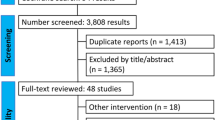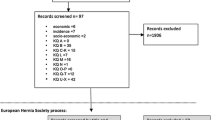Abstract
Purpose
The development of chronic pain is one of the major post-surgery problems after inguinal hernia repair. Although the possibility of chronic pain formation decreases with laparoscopic methods, pain may develop due to the staples used. It is thought that absence of mesh fixation in total extra-peritoneal (TEP) repair does not increase the recurrence rate. This study aims to investigate the absence of mesh fixation in the TEP on the development of postoperative pain, mesh displacement, and recurrence rate.
Methods
Between December 2019 and December 2020, 100 patients who underwent TEP repair due to unilateral inguinal hernia in the General Surgery Clinic of Hitit University were included in the study. Study was registered at http://Clinicaltrials.gov (NCT05152654). Patients were divided into two groups as repairs in which the mesh was fixed with a tacker and no-fixation (NF) was used. The mesh is marked with radiopaque clips. Patients were compared in terms of postoperative pain, mobilization time, hospital stay, return to work, chronic pain, early–late mesh displacement, and recurrence.
Results
While there was no significant difference between the groups in terms of mesh displacement and recurrence, it was observed that the NF group developed significantly less pain in the early and late postoperative period compared to the other group. The time-dependent reduction rate of postoperative pain was higher in NF group than in other group. In addition, operation time was shorter in the NF group.
Conclusion
While the absence of mesh fixation in TEP hernia repair does not increase the recurrence rate, it can be used safely, because it causes less acute and chronic pain.
Trail registration
Clinicaltrials number: NCT05152654.





Similar content being viewed by others
References
Maneck M, Köckerling F, Fahlenbrach C et al (2020) Hospital volume and outcome in inguinal hernia repair: analysis of routine data of 133,449 patients. Hernia 24:747–757
Legutko J, Pach R, Solecki R et al (2008) The history of treatment of groin hernia. Folia Med Cracov 49:57–74
Ger R (1998) Historical aspects of laparoscopic hernia repair. Semin Laparosc Surg 5:212–216
Krishna A, Bansal VK, Misra MC et al (2019) Totally extraperitoneal repair in inguinal hernia: more than a decade’s experience at a tertiary care hospital. Surg Laparosc Endosc Percutan Tech 29:247–251
Stavert B, Chan DL, Ozmen J et al (2019) Laparoscopic totally extra-peritoneal groin hernia repair with self-gripping polyester mesh: a series of 780 repairs. ANZ J Surg 89:1261–1264
Iraniha A, Peloquin J (2018) Long-term quality of life and outcomes following robotic assisted TAPP inguinal hernia repair. J Robot Surg 12:261–269
Chao G, Runzhi Z, Yacheng X, Rexiati R, Zhibo Y, Guangyong Z (2021) The learning curve for laparoscopic ınguinal hernia repair: an analysis of the first 109 cases. Ind J Surg 83:892–896. https://doi.org/10.1007/s12262-020-02208-9
Shatari T, Nozawa K, Mieno K et al (1998) A new method of peritoneal closure following laparoscopic herniorrhaphy. Surg Today 28:866–867
Phillips EH, Arregui M, Carroll BJ, Corbitt J, Crafton WB, Fallas MJ, Filipi C, Fitzgibbons RJ, Franklin MJ, McKernan B et al (1995Jan) Incidence of complications following laparoscopic hernioplasty. Surg Endosc 9(1):16–21. https://doi.org/10.1007/BF00187878
Andresen K, Fenger AQ, Burcharth J et al (2017) Mesh fixation methods and chronic pain after transabdominal preperitoneal (TAPP) inguinal hernia surgery: a comparison between fibrin sealant and tacks. Surg Endosc 31:4077–4084
HerniaSurge Group (2018) International guidelines for groin hernia management. Hernia J Hernias Abdom Wall Surg 22:1–165
Teng YJ, Pan SM, Liu YL et al (2011) A meta-analysis of randomized controlled trials of fixation versus nonfixation of mesh in laparoscopic total extraperitoneal inguinal hernia repair. Surg Endosc 25:2849–2858
Tam K-W, Liang H-H, Chai C-Y (2010) Outcomes of staple fixation of mesh versus nonfixation in laparoscopic total extraperitoneal inguinal repair: a meta-analysis of randomized controlled trials. World J Surg 34:3065–3074
Köninger J, Redecke J, Butters M (2004) Chronic pain after hernia repair: a randomized trial comparing Shouldice. Lichtenstein and TAPP Langenbecks Arch Surg 389:361–365
Łomnicki J, Leszko A, Kuliś D et al (2018) Current treatment of the inguinal hernia—the role of the totally extraperitoneal (TEP) hernia repair. Folia Med Cracov 58:103–114
Lomanto D, Katara AN (2006) Managing intra-operative complications during totally extraperitoneal repair of inguinal hernia. J Minimal Access Surg 2:165–170
Hung T-Y, Wu C-C, Chen L-S et al (2020) Safety of two common laparoscopic inguinal herniorrhaphy approaches: an updated systematic review with meta-analysis of randomized clinical trials. Transl Androl Urol 9:2007–2021
Gavriilidis P, Davies RJ, Wheeler J et al (2019) Total extraperitoneal endoscopic hernioplasty (TEP) versus Lichtenstein hernioplasty: a systematic review by updated traditional and cumulative meta-analysis of randomised-controlled trials. Hernia 23:1093–1103
Sanders DL, Waydia S (2014) A systematic review of randomised control trials assessing mesh fixation in open inguinal hernia repair. Hernia J Hernias Abdom Wall Surg 18:165–176
Novik B, Hagedorn S, Mörk U-B et al (2006) Fibrin glue for securing the mesh in laparoscopic totally extraperitoneal inguinal hernia repair. Surg Endosc Interv Tech 20:462–467
Burgmans JPJ, Schouten N, Clevers GJ et al (2015) Pain after totally extraperitoneal (TEP) hernia repair might fade out within a year. Hernia J Hernias Abdom Wall Surg 19:579–585
Bansal VK, Asuri K, Panaiyadiyan S et al (2016) Comparison of absorbable versus nonabsorbable tackers in terms of long-term outcomes, chronic pain, and quality of life after laparoscopic incisional hernia repair: a randomized study. Surg Laparosc Endosc Percutan Tech 26:476–483
Burgmans JPJ, Voorbrood CEH, Van Dalen T et al (2016) Chronic pain after TEP inguinal hernia repair, does MRI reveal a cause? Hernia 20:55–62
Langenbach MR, Berengolts A, Langenbach MR et al (2017) Chronic pain after laparoscopic inguinal hernia repair depends on mesh implant features: a clinical randomised trial. Open J Pain Med 1:014–020
Eklund A, Montgomery A, Bergkvist L et al (2010) Chronic pain 5 years after randomized comparison of laparoscopic and Lichtenstein inguinal hernia repair. Br J Surg 97:600–608
Köckerling F, Schug-Pass C (2017) Early surgical intervention following inguinal hernia repair with severe postoperative pain. Front Surg 30(4):67. https://doi.org/10.3389/fsurg.2017.00067
Niebuhr H, Wegner F, Hukauf M et al (2018) What are the influencing factors for chronic pain following TAPP inguinal hernia repair: an analysis of 20,004 patients from the Herniamed Registry. Surg Endosc 32:1971–1983
Sajid MS, Ladwa N, Kalra L et al (2012) A meta-analysis examining the use of tacker fixation versus no-fixation of mesh in laparoscopic inguinal hernia repair. Int J Surg Lond Engl 10:224–231
Claus CMP, Rocha GM, Campos ACL, Paulin JAN, Coelho JCU (2017) Mesh displacement after bilateral ınguinal hernia repair with no fixation. JSLS 21(3):e2017.00033. https://doi.org/10.4293/JSLS.2017.00033
Darwish A (2016) Tack fixation versus nonfixation of mesh in laparoscopic transabdominal preperitonaeal hernia repair. Egypt J Surg 35(4):327–331
Buyukasik K, Ari A, Akce B et al (2017) Comparison of mesh fixation and non-fixation in laparoscopic totally extraperitoneal inguinal hernia repair. Hernia J Hernias Abdom Wall Surg 21:543–548
Funding
The study had no funding source.
Author information
Authors and Affiliations
Corresponding author
Ethics declarations
Conflict of interest
Authors declares that they have no conflict of interest.
Ethical approval
Ethical approval was obtained from The Hitit University Faculty of Medicine Clinical Research Ethics Committee.
Human and animal rights
This study was conducted in accordance with the WMA DECLARATION OF HELSINKI and ethical rules. Animal and human rights are respected.
Informed consent
Informed consent was obtained from all patients.
Additional information
Publisher's Note
Springer Nature remains neutral with regard to jurisdictional claims in published maps and institutional affiliations.
Rights and permissions
About this article
Cite this article
Yıldırım, M.B., Sahiner, I.T. The effect of mesh fixation on migration and postoperative pain in laparoscopic TEP repair: prospective randomized double-blinded controlled study. Hernia 27, 63–70 (2023). https://doi.org/10.1007/s10029-022-02587-w
Received:
Accepted:
Published:
Issue Date:
DOI: https://doi.org/10.1007/s10029-022-02587-w




